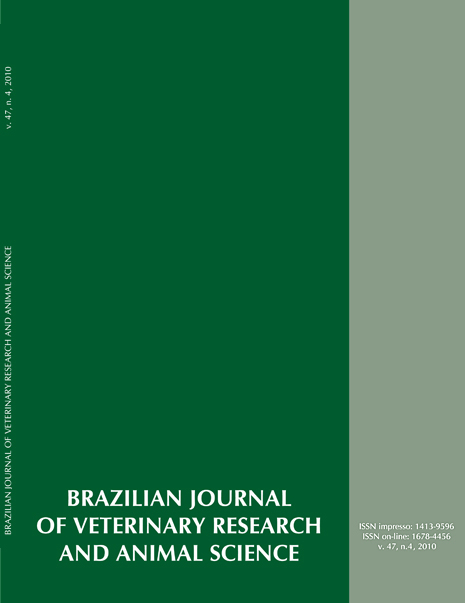Avaliation of perioperative conservative treatment in pyometra ovariohysterectomy bitches of in acute renal failure
DOI:
https://doi.org/10.11606/issn.1678-4456.bjvras.2010.26827Keywords:
Fluid terapy, Clearance, Kidney, Dogs, Acid-base status, PiometraAbstract
Acute renal failure (ARF) was evaluated prospectively in 351 female dogs with piometra, 132 animals were selected for this study, fulfilling the following criteria, measured in three moments (immediately after the diagnosis, 24 hours after the hysterectomy and when the suture was removed): creatinine > 2.4 mg/dL and/or urea > 80 mg/dL and/or relative increases of 100% in comparison with values previously obtained. The animals selected for the prospective study received conservative treatment consisting in lactated Ringer solution, with the maximum dose of 90 mL/kg/hr, during four hours. The factors evaluated before and after the therapy were: weight, systolic arterial pressure, heart rate, renal function, arterial hemogasometry, serum and urinary biochemistry and the endogenous renal creatinine clearance. The evaluated parameters showed significant statistical differences (p < 0.05) when companing: PAS (systolic arterial pressure), urinary pH, wheigt, serum urea and creatinine, excretion electrolyte rate and creatinine clearance. Howerer, the survining animals (79.6%) that received the treatment described above showed decresead levels of serum creatinine- 2,38 ± 1,33mg/dL and median 2.2 mg/dL - when compared to the non-survining animals (20.4%) that received the same treatment - 5.54 ± 3.0mg/dL and median 4.4mg/dL - (p < 0.0001). When comparing the endogenous creatinine clearance, the survining animals had higher values - 1.82 ± 1.74mL/kg/min and median 1.34 mL/kg/min - than the non-survining animals - 0.36 ± 0.38 mL/kg/min and median 0.23 mL/kg/min - (p < 0.0001). Concluding: the criteria used to include the animals in this study can help to select the severely affected animals. Values higher than 1mL/kg/min are considered as a good prognosis while values lower than 1mL/kg/min are considered as a restricted prognosis. Values lower than 0.5 mL/kg/min are considered as strong predictors of severe renal failure or death.Downloads
Download data is not yet available.
Downloads
Published
2010-08-01
Issue
Section
UNDEFINIED
License
The journal content is authorized under the Creative Commons BY-NC-SA license (summary of the license: https://
How to Cite
1.
Ferreira PC de C, Stopiglia AJ, Oliveira CM de, Andrade L da C, Fantoni DT, Barbosa D, et al. Avaliation of perioperative conservative treatment in pyometra ovariohysterectomy bitches of in acute renal failure. Braz. J. Vet. Res. Anim. Sci. [Internet]. 2010 Aug. 1 [cited 2024 Apr. 25];47(4):282-9. Available from: https://www.revistas.usp.br/bjvras/article/view/26827





